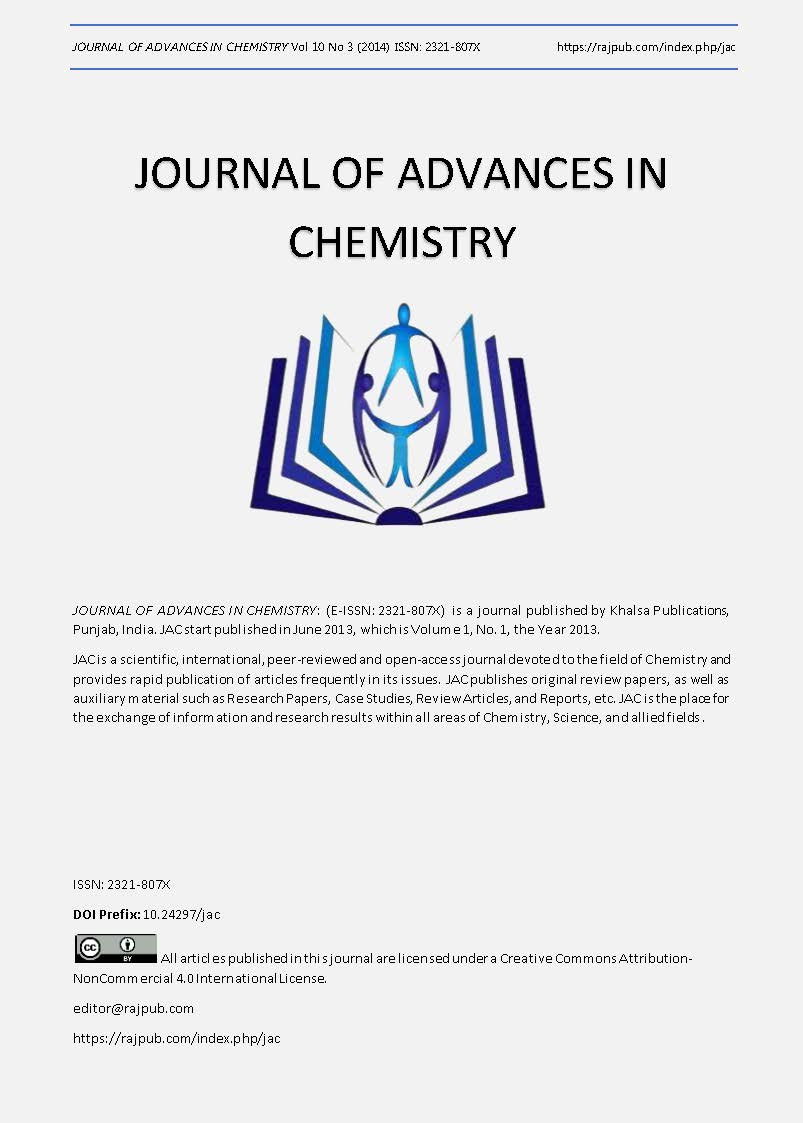Activity and stability of immobilized Candida rugosa lipase on chitosan coated Fe3O4 nanoparticles in aqueous and organic media
DOI:
https://doi.org/10.24297/jac.v10i3.6652Keywords:
Lipase; magnetic nanoparticles; chitosan; immobilization, Lipase, magnetic nanoparticles, chitosan, immobilizationAbstract
Fe3O4 (magnetite) nanoparticles were prepared by coprecipitation method, coated by chitosan and functionalized by glutaraldehyde. Lipase enzyme from Candida rugosa was immobilized on the prepared particles via cross linking reaction. Synthesis steps and characterization were examined by XRD, TEM, and FTIR.
The immobilization conditions were 10 mL of phosphate buffer (0.1 M, pH 6.5) containing 30 mg of functionalized magnetic chitosan nanoparticles and 2.0 mg·mL-1 of lipase, immobilization temperature of 4 ℃ and immobilization time of 1 h. Under these conditions, lipase was successfully immobilized with loading capacity of 87 mg/g.
The immobilized enzyme showed good operational and storage stability, where it remained stable after 30 days of storage at 4â—¦C.and retained about 61% of its initial activity after twenty repeated uses. Finally enzymatic catalyze synthesis of butyl and hexyl oleate at 40 â—¦C with shaking (200 rpm) was realized in n-hexane and confirmed by GC analysis.
Downloads
References
2. S.W. Chang, J.F. Shaw, K.H. Yang, S.F. Chang, C.J. Shieh; Studies of optimum conditions for covalent immobilization of Candida rugosa lipase on poly(γ-glutamic acid) by RSM. Bioresour. Technol. 99:8 (2008) 2800–2805.
3. O. Yemul, T. Imae; Covalent-Bonded Immobilization of Lipase on Poly(phenylene sulfide) Dendrimers and Their Hydrolysis Ability. Biomacromolecules 6:5 (2005) 2809–2814.
4. Y. Liu, S. Jia, Q. Wu, J. Ran, W. Zhang, S. Wu; Studies of Fe3O4-chitosan nanoparticles prepared by coprecipitation under the magnetic field for lipase immobilization. Catalysis Communications 12 (2011) 717–720.
5. C. Kuoa, Y. Liub, C. Changb, J. Chenc, C. Changa, C. Shieh; Optimum conditions for lipase immobilization on chitosan-coated Fe3O4 Nanoparticles. Carbohydrate Polymers 87 (2012) 2538– 2545.
6. M. Moeder, C. Martin, G. Koeller; Degradation of Hydroxylated Compounds Using Laccase and Horseradish Peroxidase Immobilized on Microporous Polypropylene Hollow Fiber Membranes. J. Membrane Sci. 245 (2004) 183-190.
7. A. DomÃnguez, J. Gómez, M. Lorenzo, et al. Enhanced Production of Laccase Activity by Trametes Versicolor Immobilized into Alginate Beads by the Addition of Different Inducers. World J. Microb. Biot. 23 (2007) 367-373.
8. S. Timur, N. Pazarlıoğlu, R. Pilloton, A. Telefoncu; Thick Film Sensors Based on Laccases from Different Sources Immobilized in Polyaniline Matrix. Sensors and Actuators B: Chemical. 97 (2004) 132-136.
9. D S Jiang, S Y Long, J Huang, et al. Immobilization of Pycnoporus Sanguineus Laccase on Magnetic Chitosan
Microspheres. Biochem. Eng. J. 2005, 25: 15-23
10. H.P. Khng, D. Cunliffe, S. Davies, N.A. Turner, E.N. Vulfson; The synthesis of sub-micron magnetic particles and their use for preparative purification of proteins Biotechnol. Bioeng. 60 (1998) 419–424.
11. K.J. Dussan, C.A. Cardonaa, O. Giraldo; Immobilization and characterization of the Candida rugosa lipase enzyme on magnetic particles. Revista Mexicana de Fısica S 58:2 (2012) 47–51.
12. M. Borowskaa, T. Siódmiakb, D. Chełminiaka, A. Cyganiuka, M. P. Marszałł; Magnetic nanoparticles with surfaces modified with chitosan–poly[N-benzyl-2-
methacryloxy)-N, dimethylethanaminium bromide]for lipase immobilization. Applied Surface Science 288 (2014) 641– 648
13. T. Siodmiak, M. Ziegler-Borowska, M.P. Marszałł; Lipase-immobilized magnetic chitosan nanoparticles for kinetic resolution of (R,S)-ibuprofen. Journal of Molecular Catalysis B: Enzymatic 96 (2013) 7-14.
14. E. Yilmaz, M. Sezgin, M. Yilmaz; Immobilization of Candida rugosa lipase on magnetic sol–gel composite supports for enzymatic resolution of (R,S)-Naproxen methyl ester. J. Molecular Catalysis B: Enzymatic 69 (2011) 35–41.
15. R. Jalal, Z. M. Milani, E. K. Goharshadi; Immobilization of α-amylase onto magnetic nanoparticles by shaking method. First national Iranian new chemistry congress. 5-6 may (2011) shiraz 874-880.
16. H. Ghamgui, Maha Karra-Chaabouni , Y.Gargouri; 1-Butyl oleate synthesis by immobilized lipase from Rhizopus oryzae: a comparative study between n-hexane and solvent-free system. Enzyme and Microbial Technology 35
(2004) 355–363.
Downloads
Published
How to Cite
Issue
Section
License
 All articles published in Journal of Advances in Linguistics are licensed under a Creative Commons Attribution 4.0 International License.
All articles published in Journal of Advances in Linguistics are licensed under a Creative Commons Attribution 4.0 International License.




